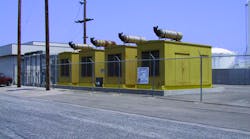Fuel costs constitute a large share — often up to 30 percent — of airline operating expenses. That has made effective management and efficient distribution of fuel supplies at large airports an industry priority for decades.
In the late 1970s, airlines at several major airports began looking at a consortium model to lower costs and increase efficiencies. The fuel consortium model has also helped airports garner similar benefits.
Looking For Options
Before the fuel consortium era, fuel storage and distribution at major airports typically was controlled by major oil companies. In many cases, each oil company had its own distribution system to supply specific concourses. The San Francisco and Los Angeles airports, for example, operated in this manner. These structures limited competition and the opportunity for airlines to introduce new supply sources to the airport, and resulted in higher fuel costs for the airlines. The oil companies’ costs associated with these facilities were passed on to the airlines as part of their fuel cost.
Competing airlines came together in a revolutionary response, collectively seeking a free market for fuel pricing and fuel system operations at major airports. The first airports to establish airline consortia were in Chicago, Honolulu, and Anchorage, Alaska. In the mid-1980s, many airline consortia were formed to manage facilities in Las Vegas, Phoenix, Seattle, and Los Angeles.
The LAXFUEL Corp. consortium at the Los Angeles International Airport (LAX) represented a major breakthrough because it included off-airport storage and access to ports, which enabled airlines to import jet fuel to the West Coast for the first time. It also let airlines take advantage of bonded fuel, which eliminated the import duty on international flights out of LAX. United Airlines led this effort, with significant support from American, Delta, Pan Am, Western, Flying Tigers, KLM, and Lufthansa.
Coming Together at LAX
Oil companies — including Chevron, Shell, Unocal, ARCO, Mobil, and GATX — owned and operated several large fuel storage and hydrant systems at LAX. Some larger airlines — American, Pacific Southwest Airlines, and Trans World Airlines — owned their own fuel storage and/or hydrant systems. Because each oil company pipeline into the airport connected directly to refineries in the area and no common carrier pipelines existed, the airlines were at the mercy of the oil companies that served the airport.
In 1985, airlines formed a California Mutual Benefit Corporation to purchase the oil company facilities on the airport, lease the property and rights-of-way from the airport authority, finance the acquisitions and improvements, and manage the fuel infrastructure and operations. LAXFUEL was designed to create an open market and enable the sharing of one fuel storage facility on airport property for all member airlines’ use.
The cooperation of the LAX Airport Authority was essential to facilitate the creation of this integrated fuel storage and distribution system. LAXFUEL leases additional off-site storage facilities to better position the airlines to purchase and store fuel near the airport. Each airline purchases its own fuel as needed and uses the common facilities. The fuel is comingled and accounting of fuel usage and inventory is handled by the fuel system operator.
Burns & McDonnell worked with LAXFUEL to design and build a 600,000-barrel fuel storage facility that integrates the oil company facilities and new storage capacity with existing fuel hydrant systems. Consortium members share the infrastructure, operation, and maintenance costs for the facilities based on each carrier’s consumption as a percentage of total airport volume.
A Spreading Model
Fuel consortia have become a common operational model at major airports in the U.S. and around the world with airlines operating at midsize to smaller airports adopting the model of shared facilities to reduce costs. Airlines and airport authorities continue to evaluate whether this model can apply to other airport operations. Consortia offer an opportunity for airlines to work together — and with airport management — to manage collective activities more efficiently and cost-effectively.
Other services could be managed by an airline consortium and range from the procurement of common needs, such as skycap services, to maintenance of collectively used equipment, such as baggage handling systems or passenger boarding bridges. Going forward, it may be possible to translate the benefits of airline consortia management to other activities, including ground support equipment maintenance and aircraft deicing.
Airports have benefited from the airlines forming fuel consortiums. It is easier for an airport to work on lease terms and master planning with airlines instead of oil companies. There is a familiarity with the companies operating multiple facilities at the airport rather than large oil companies that are only interested in the fuel facility. In situations where the airport has owned and operated the fueling facilities, there is a reduced need for staff expertise in fueling design, construction, and operations when the airlines take on those responsibilities.
Typically the fuel consortium will integrate several parts of a fuel system at an airport into one more efficient system. This has been the case in Honolulu, Los Angeles, San Francisco, and other large airports where multiple oil companies operated several independent fuel farms at one airport.
Moving further into the 21st century, efficiency in operations is the goal of all parties. Airlines are faced with higher fuel and operating costs, and they continue to look for ways to be more competitive — Delta Airlines buying a refinery in the Northeast in April 2012 is one more example of building out tighter control of the supply chain.
Perhaps we may soon see airlines buying leases in the Gulf of Mexico or purchasing fuel tanker ships or pipelines to move jet fuel to major airports.



